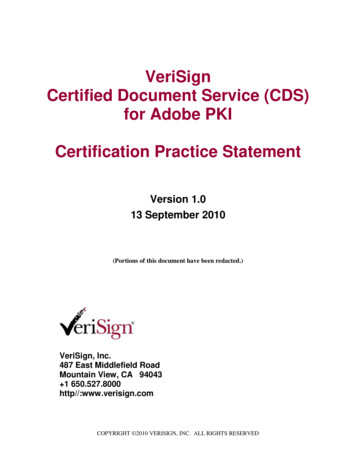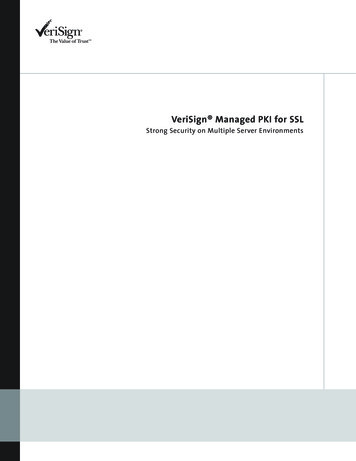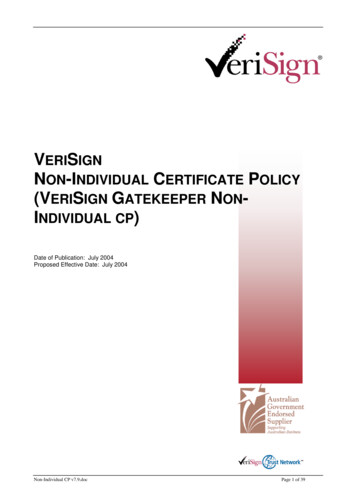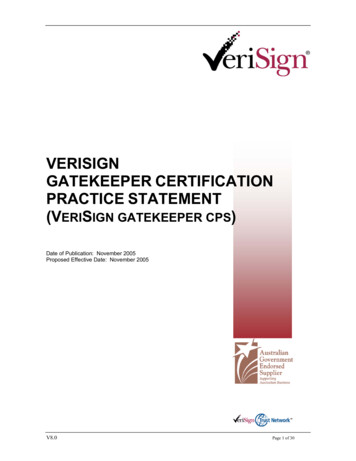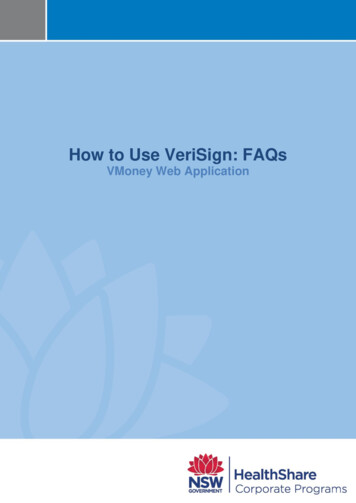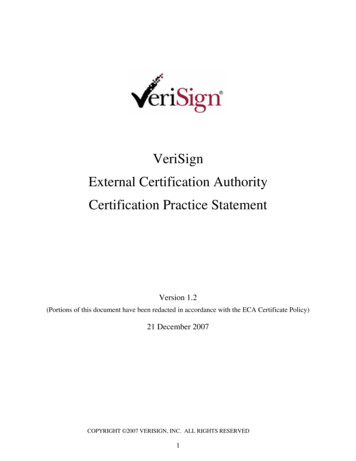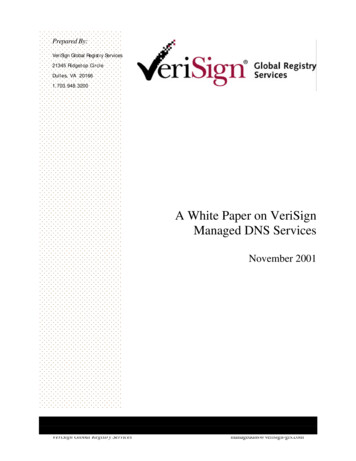
Transcription
Prepared By:VeriSign Global Registry Services21345 Ridgetop CircleDulles, VA 201661.703.948.3200A White Paper on VeriSignManaged DNS ServicesNovember 2001VeriSign, Inc.VeriSign Global Registry m
VeriSign Secondary Name Server HostingIntroductionIf your business depends on the Internet, you understand the importance of a reliableDomain Name System (DNS) infrastructure. Every Web site request and every emailsent through the Internet must pass through the DNS in order to reach its intendedlocation. A less than optimal DNS infrastructure to support your Web presence can resultin poor resolution time or even complete inaccessibility, meaning lost business anddissatisfied customers. Conversely, a robust and reliable DNS can reduce resolutiontimes, leading to an enhanced customer experience and increased sales.The domain name space is comprised of zones that many companies manage on their ownname servers. Although the term is often used interchangeably with domain, thedifference is that a zone is the administratively delegated portion of the domain thatcomprises the authoritative information used to direct Internet users to a company’s Website(s). Managing a zone and its authoritative name servers requires time, money, and anadministrator with substantial training and experience. The expertise of an administratoris critical, as the syntax of zone data files and name server configuration files is subtleand unforgiving.To ensure robustness, name servers on different networks should service a zone. Toprovide optimal performance, a zone’s name servers should be distributed throughout theInternet, as close to users and hosts as possible. These two steps will greatly reduce thelikelihood of inaccessibility and ensure that resolution times are kept to a minimum.Studies have shown that in today’s fast-paced world of e-commerce, delays of as little asone second can greatly affect the “bail out” rates of potential customers visiting Websites. Building DNS infrastructures close to these customers can help reduce resolutiontimes.The cost of placing and operating servers in multiple, strategic locations is prohibitive tomost organizations. The result is that companies often limit the number and distributionof their name servers, which makes them vulnerable to catastrophic failures when DNSproblems occur.This paper outlines the intricacies of DNS in terms of how it works and what its biggestchallenges are for a company administering its own DNS. In addition, it discussesVeriSign Secondary Name Server Hosting, which can help companies alleviate some oftheir concerns around DNS and concentrate their resources on core business initiatives.Domain Name System OverviewThe Domain Name System (DNS) is part of the fabric that holds together today’s modernInternet. It performs a simple, straightforward function: mapping names to IP addressesand back. When it breaks, the effects are severe and widespread.VeriSign, Inc.VeriSign Global Registry m
Every Web server on the Internet has one or more unique IP addresses. An IP address is asimple set of four numbers separated by dots (e.g., 204.14.78.100). Any Internet user (viaa Web browser) can contact any Web server on the Internet by simply typing in the IPaddress. However, it is difficult for most people to remember more than a few IPaddresses, just as it is difficult for most people to remember more than a few phonenumbers.DNS allows people to use names (e.g., “company.com”) to identify Web servers, ratherthan IP addresses. DNS performs the translation between the name and the IP address oraddresses. When an Internet user types “company.com” into a Web browser, DNStranslates that domain name into an IP address. The browser then connects to the Webserver at that address. The diagram below demonstrates this simple process.The service DNS provides—mapping names to addresses—is supported by an entireglobal network of name servers, managed by many different organizations and arrangedin a tree-like structure. No single name server knows every Web server’s address, buteach can navigate the hierarchy until it eventually finds another name server that doesknow the address.VeriSign, Inc.VeriSign Global Registry m
As the diagram above demonstrates, the root name servers do not know where thecompany.com Web server is located, but they can refer an inquiry to the .com nameservers. While the .com name servers also do not know where the company.com Webserver is located, they can refer an inquiry to the company.com name servers, which doknow the IP address of the company.com Web server. Understanding this hierarchy iscritical to understanding the need for geographically distributed name servers.The information that translates domain names into IP addresses has two othercharacteristics that are important to understand.Name servers around the world cache information from other name servers. For example,the first time one of an ISP’s customers tries to access company.com, the ISP's nameservers will likely have to ask one of the com name servers and then one of thecompany.com name servers, to get the IP address of company.com’s Web server. But theISP's name server remembers that answer so that the next time it’s asked, it will refer theuser directly to company.com’s Web server.There is a time limit on how long name servers can cache the information. This limit,called Time-To-Live (TTL), is determined by company.com’s name servers. Theybasically say, “Here is the answer, and I would appreciate it if you would remember thisonly for the next hour” (or whatever period the administrator of company.com haschosen).Managing the ProcessAlthough this illustration seems basic, a DNS administrator knows how much can gowrong and how much administration is involved in keeping it running. ComprehensiveDNS management is complex. It requires careful planning, substantial expertise, andconsiderable resources, and is critical to the effective operations of business on theVeriSign, Inc.VeriSign Global Registry m
Internet. Unfortunately, most companies do not recognize the faults in their existing DNSinfrastructure until it is too late–and they have lost revenue and customers.A study conducted by IDC determined that only 41% of small companies and 35% oflarge organizations monitor Internet DNS response times. The majority of time devotedto DNS is spent on updating and fixing DNS problems. In addition to poor monitoringhabits, companies also tend to have their DNS servers poorly distributed. In a studyconducted by Men & Mice of six thousand randomly selected .com domains, 38% oftested zones were located in one subnet, increasing the risk of a single point of failurebringing down a company’s name service. This can result in preventing customers fromreaching a company’s site.According to the IDC study, the number of DNS name servers around the world isgrowing at an annual rate of close to 30% and companies recognize the impact of poorname resolution. Regardless, the relative importance placed on DNS servers within acompany may not be growing as rapidly.Key DNS Management LessonsWhether a company is managing its own DNS infrastructure or outsourcing managementto another organization, there are important guidelines to follow to ensure that DNS isdesigned properly and can provide robust, uninterrupted service:Establish multiple name servers to serve zones.This ensures that the failure of one of your name servers does not cut zones off from theInternet.Distribute name servers geographically.Locating name servers close to the communities of users who need them will help usersaccess Web sites quickly and insulate them from the frequent failures of transoceanicInternet links. For example, a substantial user base in Asia could justify at least one nameserver in Asia.Connect name servers to different ISP networks.This ensures that the failure of one ISP does not cut zones off.Provide name servers with fast, high-bandwidth connections to the Internet.Combined with geographic diversity and the use of multiple ISPs, this would make DNSinfrastructure highly resistant to a distributed denial of service attack.Ensure that skilled DNS administrators maintain DNS infrastructure.12IDC Study, March 1999Men & Mice Study, 2000VeriSign, Inc.VeriSign Global Registry m
Inexperienced administrators can make seemingly minor configuration mistakes that havea profound and wide-ranging impact on customers.Monitor name servers.Monitoring only the hardware or operating system is insufficient. A company mustmonitor the availability and responsiveness of the name server itself. There are not manyoff-the-shelf tools to do this, but even the simplest monitor is beneficial.Create a business continuity plan for DNS.A company should consider augmenting its DNS infrastructure with additional DNSservers in additional locations.Institute a change process.Ensure that new name server configurations and zone data are tested before they are putinto production.VeriSign Managed DNS Services: An OverviewVeriSign understands the complexities of operating a reliable, secure, and robust DNSinfrastructure and has implemented these key points in developing a DNS managementproduct suite: VeriSign Managed DNS Services. VeriSign Managed DNS Services willoffer customers the ability to outsource a part of or their entire Internet facing DNSinfrastructure and operations. First two offerings within the suite are VeriSign DNSHosting and DNS High-Availability Service.VeriSign DNS Hosting provides customers the ability to easily and securely manage theirzones through a Web-based user interface, or delegate management authority to theiroutsourced technical service provider, relieving staff of those administrative duties.Customer and domain name data is stored securely behind a firewall on an Oracledatabase. Zone data is generated from the database and transferred over a VPN to anextensive secondary name server constellation. VeriSign’s server constellation receives24x7 operational support from the same skilled operators and engineers who manage the.com, .net, and .org generic Top Level Domain (gTLD), arguably the most critical zonesin the world.VeriSign, Inc.VeriSign Global Registry m
Figure 1 VeriSign DNS Hosting ServiceVeriSign DNS High-Availability service offers an outsourced secondary DNS solutionfor companies that want to maintain control over their zone data, yet do not want to incurthe added expense of implementing and supporting extensive DNS infrastructure. Itallows a company’s zones to be hosted on VeriSign’s global name server constellation.The company retains complete control over the zone data by maintaining its own primaryname server and using established tools and processes to update the zone files. VeriSignname servers take the load off a company’s name server by answering all Web and emailqueries, providing unmatched performance, reliability, and geographical distribution.Figure 2 VeriSign DNS High-Availability ServiceThe ConstellationThe VeriSign gTLD sites are the heart of Secondary Name Server Hosting. VeriSignoperates the thirteen gTLD name servers, which answer queries for data in the .com, .net,and .org zones. These gTLD name servers are located at the topological cores of theInternet around the world, providing local name service throughout North America, inEurope, and in Asia. This “constellation” of name servers is one of the lynchpins of theInternet’s DNS ATROPIC OF NOCEANAEQUATOR10N2020TROPIC OF CAPRICORN40PACIFICOCEANSOUTHAMERICA1050ASIATROPIC OF 5080DANNLEEGR70201020TROP OF 50506060707080VeriSign, Inc.VeriSign Global Registry ign-grs.com
Figure 3 Global gTLD LocationsIn addition to supporting the gTLD name servers, each of the VeriSign gTLD sites housestwo name servers that host a company’s zones. These name servers are connected to thesame networks that the gTLD name servers use, and are monitored by VeriSignoperations staff around the clock.Server PlatformVeriSign hosts a company’s zones on dual 1 GHz Pentium III-based servers runningLinux and BSD-based operating systems. Each server is loaded with 2 GB of RAM and36 GB of hot-swappable SCSI disks in a RAID configuration. Multiple powerdistribution units feed each server, which are, in turn, fed by different power sources ineach data center.Server SoftwareVeriSign runs special name server software tuned to the requirements of an authoritative(rather than caching) name server. With this software, the VeriSign name servers boastexceptional performance, sustaining query rates an order of magnitude greater than theperformance of a standard BIND name server.Network ConnectivityEach gTLD site has four 100 Mbps connections to the Internet. One, the primaryconnection, carries query and response traffic. One is used solely for management of thename servers and staging of zones. The last two provide redundant backup connections tothe Internet.In 2001, VeriSign will upgrade most gTLD sites to 1 Gbps connections.ManagementVeriSign operations staff uses Somix Technology’s WebNM, Concord’s eHealth Suite,and custom-built support tools to monitor and manage the name servers at the gTLDsites. VeriSign also has aggressive support contracts with all of its hardware vendorsstipulating rapid response times for repair and replacement.SecurityAll management of the VeriSign name servers is conducted over a virtual private network(VPN) between the VeriSign corporate network and the gTLD sites. Staging zones overan encrypted VPN connection helps ensure the integrity of zone data, while administeringthe name servers over the VPN helps maintain the security of the name server platforms.The use of the separate VPN connection also ensures that VeriSign operations staff isable to manage the name servers at the gTLD sites no matter how busy the name serversare answering queries.VeriSign, Inc.VeriSign Global Registry m
Scalability and AvailabilityThe name servers at the gTLD sites are designed to operate at no more than 20% of theircapacity. VeriSign continuously monitors the name servers and will upgrade as necessaryto ensure premium performance levels. All the components at the gTLD sites are fullyredundant. This, coupled with the use of commercial Alteon load balancers to distributeincoming query load between name servers, ensures that the failure of any singlecomponent will not result in a disruption of service.System CapabilitiesVeriSign name servers support all of the latest DNS protocol enhancements, providing acompany with outstanding security and flexibility.Zone TransfersVeriSign name servers support both old-style zone transfers (AXFR) and more efficientincremental zone transfers (IXFR). Customers running IXFR-capable primary mastername servers may choose to have VeriSign name servers use incremental zone transfersto reduce load on their primary masters and to speed synchronization betweenauthoritative name servers.VeriSign name servers also support transaction signatures (TSIG), whichcryptographically authenticate zone data transferred from a company’s primary mastername servers to the VeriSign name servers.DNS Security (DNSSEC) SupportDNSSEC, the DNS Security Extensions, provide cryptographic origin authentication andintegrity verification of zone data. For a company conducting electronic commerce,DNSSEC-secured zones are invaluable.VeriSign name servers support all DNSSEC resource records. Customers still maintainabsolute control over their secure zones, securing their zones on their primary mastername servers. VeriSign name servers then transfer and advertise those zones.SummaryDNS is a critical part of a company’s Web presence and email system, and requires acomprehensive management strategy. Even a small improvement in DNS infrastructurecan lead to increased profits through greater customer satisfaction. VeriSign ManagedDNS Services provide outsourced solutions to help companies meet their on-goingdemands of their Web-based markets so they can focus on key business objectives.While outsourced DNS is not the right solution for every company, it is the right solutionfor companies that want to maximize the benefits of a well-managed DNS withoutincurring the significant costs of operating a DNS infrastructure in-house.VeriSign, Inc.VeriSign Global Registry m
in a tree-like structure. No single name server knows every Web server's address, but . to another organization, there are important guidelines to follow to ensure that DNS is designed properly and can provide robust, uninterrupted service: . VeriSign Managed DNS Services. VeriSign Managed DNS Services will
